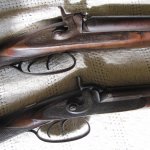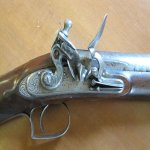You are using an out of date browser. It may not display this or other websites correctly.
You should upgrade or use an alternative browser.
You should upgrade or use an alternative browser.
12g J manton
- Thread starter the deer hunter
- Start date
gunsaholic
CGN Ultra frequent flyer
- Location
- Winnipeg, Manitoba
Show us pics of the complete gun, pics of the locks and pics of the proof marks on the underside of the barrels. But, does it say Joseph Manton or J Manton & Co? Joseph Manton himself died in 1835.
Last edited:
Londonshooter
CGN frequent flyer
- Location
- SW Ontario
If it has London proof marks rather than Belgian that should tell you real Manton vs. fake.
In the 1890's through the 1930's unscrupulous Belgian makers used the names of well known but defunct Btitish makers such as Manton, Moore and others as well as misspelled versions of famous names still in business such as Purdy, etc to brand extremely poor quality hammer guns for export. They flooded the North American market with these, every small town hardware store was selling them. They loosened up and broke down very quickly, as most homesteader's only gun they were used hard and rarely cared for. There are thousands of them still floating around, a shootable one sells for $100-150, most are junk.
Look for the proof marks on the underside of the breech end of the barrels. If you see ELG or an L sort of symbol similar to the English pound (money) sign you have ABC - Another Belgian Clunker. On the other hand, if the obvious original quality is superb and if it has London proof marks from pre 1850 ( google it) and the words Joseph Manton London engraved on the top rib you may have a fine gun that could be interesting to collectors. Joseph Manton was the most famous gunmaker of his generation and they are collectable. His guns were all muzzleloaders, this was before breechloaders were made in Britain, although his brother John's business survived as Manton and Co into the 1890's and obviously made some breech loading guns, mostly of mediocre quality.
Look for the proof marks on the underside of the breech end of the barrels. If you see ELG or an L sort of symbol similar to the English pound (money) sign you have ABC - Another Belgian Clunker. On the other hand, if the obvious original quality is superb and if it has London proof marks from pre 1850 ( google it) and the words Joseph Manton London engraved on the top rib you may have a fine gun that could be interesting to collectors. Joseph Manton was the most famous gunmaker of his generation and they are collectable. His guns were all muzzleloaders, this was before breechloaders were made in Britain, although his brother John's business survived as Manton and Co into the 1890's and obviously made some breech loading guns, mostly of mediocre quality.
Beautiful gun Tiriaq, great example of what a top quality British gun of the period looks like. Do you also have a sample of a Belgian knock off to post for comparison? That will make the difference obvious. The British makers were very proud of their work and their name was their advertising, and their business depended on this quality. They proudly engraved their complete name and business address on their guns and vigorously defended this in court. There was no WalMart mentality, if you could make the best you prospered, there was no attempt to make sporting guns cheaper, only better and better. The Mantons, though by no means the only great gunmakers of their period were at the forefront of this movement to excellence and were famous in their own time. A Joseph Manton gun will be engraved Joseph Manton not J. Manton, Manton, Manton & Co, etc and even if very heavily used and even abused, dirty, broken, the true quality will be obvious. I have seen two John Manton guns, no Joseph Manton guns in Canada, there might be a dozen or two total, hundreds and hundreds of cheap copies.
I had a very high end Joseph Manton single barrel percussion. The gun used a proper English bar lock, had platinum plugs in the sides of the drum, was engraved and infilled with silver on the breech and on the lock, and used a silver bead front sight, and silver inlay in the stock. Had the highest quality blue I’ve seen on a gun of that age. And a black horn tipped ramrod. Inletting was perfect and the same grade I’m used to seeing in a modern beretta shotgun. And a fancy grade walnut stock. Mine was engraved Joseph Manton on the lock which also used a sliding safety behind the hammer, and London on the barrel with London proofs. The only thing I ever questioned was it said Joseph Manton.. because it was a percussion gun. That seemed a little early for a percussion where he passed in the 1830s. I wish I still had that one.
Joseph Manton started in business making flintlocks and introduced several improvements including the waterproof pan. In the early 1800's he made guns using Forsyth's patent detonator, later moving to his own patented tube lock, pellet lock and other systems and finally to percussion in the 1820's and 1830's. Many guns with earlier ignition systems were eventually converted to percussion. He had many court disputes over patent use and made a number of poor business decisions. He went bankrupt, went to debtor's prison, re established and went bankrupt again and died penniless.
Friend had a cased 20ga double Joe, made 1812. Had been converted to percussion, with original locks altered, and new fancy breechplugs installed. Work was of Manton quality, perhaps the conversion was done by Manton.
I have a rather nice Manton marked 14ga double. Birmingham gun. Too nice for a spurious name. I suspect it was marketed by the Manton (unrelated to J&J) who had a business in Montreal. Came out of the Ottawa Valley. Excellent shooter, have hunted with it quite a bit.
Here it is beside an 8ga Belgian working gun.
I used to carry a grain of wheat bulb mounted on fine wires that I could run done a muzzleloader's barrels to be able to inspect them. When I checked the "Manton" double, the faces of the breechplugs were white. It has seen use, but had always been properly cleaned. Bores are shiny.
The Wilkinson's bore is in the same condition, but I've not worked up the courage to use it yet. I've fired the 8ga Belgian. It is a 14 pound lump. Not a snap shooter.

I have a rather nice Manton marked 14ga double. Birmingham gun. Too nice for a spurious name. I suspect it was marketed by the Manton (unrelated to J&J) who had a business in Montreal. Came out of the Ottawa Valley. Excellent shooter, have hunted with it quite a bit.
Here it is beside an 8ga Belgian working gun.
I used to carry a grain of wheat bulb mounted on fine wires that I could run done a muzzleloader's barrels to be able to inspect them. When I checked the "Manton" double, the faces of the breechplugs were white. It has seen use, but had always been properly cleaned. Bores are shiny.
The Wilkinson's bore is in the same condition, but I've not worked up the courage to use it yet. I've fired the 8ga Belgian. It is a 14 pound lump. Not a snap shooter.

Attachments
Last edited:
Until recently I owned a genuine 1807 vintage John Manton 14 ga flinter single shot smooth bore. Octagon to round barrel. Marked only Manton on the lock plate with serial # stamped into the edge of the plate at the top by the ####. Patent breech with gold line around the breech and a gold inlayed rectangular cartouche on top of the breech. Serial number in several places including the tang of the trigger guard. Front end of the lock plate has a hidden hook that latches under a hidden screw so only one crossbolt holding the lock plate so do not force it out or you will split away the surrounding wood. Waterproof pan and roller on the frizzen spring. Can you post some photos and the serial number for dating? Flint or percussion?
gunsaholic
CGN Ultra frequent flyer
- Location
- Winnipeg, Manitoba
Where are you OP?










































































